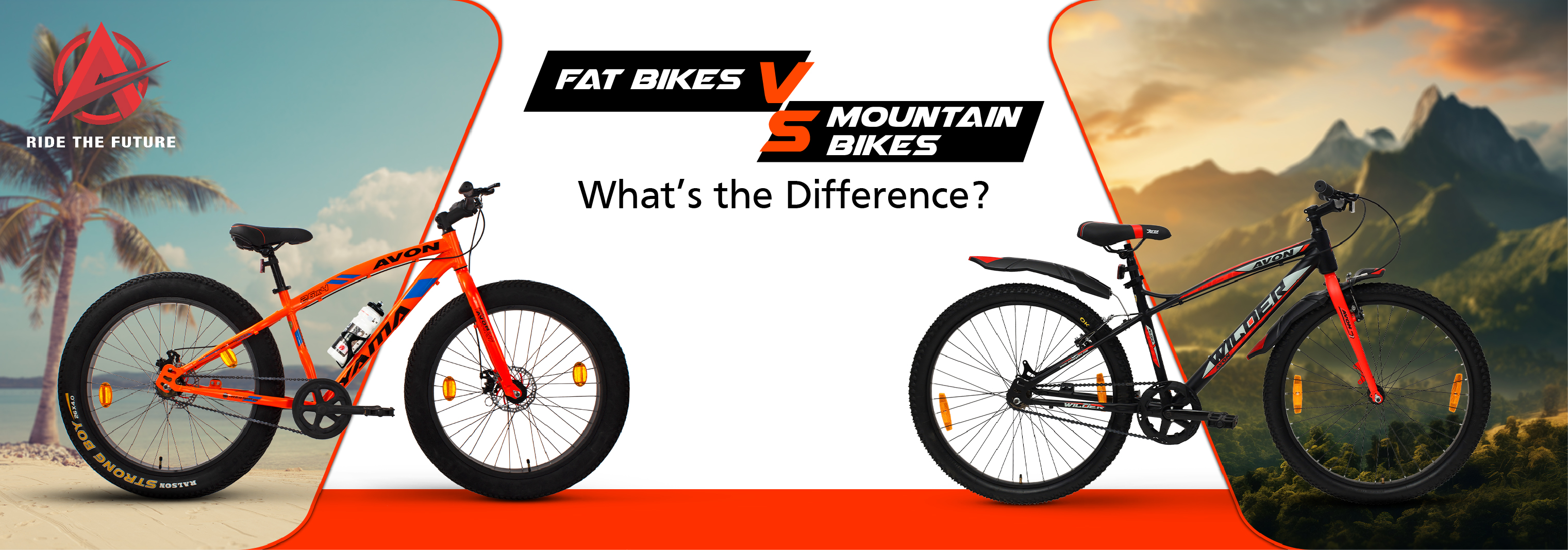 2024-07-24
2024-07-24
5 Read
Welcome to the ultimate comparison between MTB cycles and fat bicycles. Let us understand both first. Fat tire cycle features extremely thick and sturdy tires for soft terrain like sand or snow. They make riding in sand beaches or white wonderlands easy. Fat tires were created to make cycles suitable for every terrain. The bikes' larger tires give them better traction and stability on various surfaces. This covers a variety of surfaces, including pavement, sand, dirt, and snow. This works because more tire surface area touches the ground at any time. Because of such contact, the bike tires can maintain some grip on solid ground.
Comparing Terrain Capabilities: Mountain Bikes vs. Fat Bikes
As the names suggest, mountain bikes are meant to be ridden in mountain or hilly areas. Fat bike cycles were created to make cycles suitable for every terrain. The bikes' larger tires give them better traction and stability on various surfaces. This covers a variety of surfaces, including pavement, sand, dirt, and snow. This works because more tire surface area touches the ground at any time. Because of such contact, the bike tires can maintain some grip on solid ground.
These bikes were created because fat bikes could not go anywhere and explore on an exciting level. Mountain bike cycles, made for off-road routes and rough terrain, featured wide tires, robust frames, and front suspension for shock absorption.
The most significant difference between Fat bikes and mountain bikes is explained below:
Among the biggest differentiators between fat bikes and mountain bikes is tire size. A regular MTB tire width is likely around 45mm-63.5mm, whereas the fat wheel bikes have a tire width in a much more extensive range – between 93mm-127mm. Apart from the enhanced visual appeal of the fat bikes, they offer superior traction and grip.
MTB bikes come with knobby tires but are not very wide. Since MTB bikes are required for uphill climbs and off-road biking, extra wide tires might be a disadvantage.
MTB bikes have an advanced suspension system, whereas fat bikes have rigid forks. The advanced suspension setup in hardtail or complete suspension bikes enables you to ride in off-road conditions easily without feeling bumps or potholes. Fat bikes come with rigid forks, albeit with wide tires. The wide tires of fat bikes can soak in the bumps to compensate for the lack of suspension.
Handlebars are one of the differences between a fat bike and a mountain bike. On mountain bikes, drop bars are curved handlebar sets that provide riders with three different hand positions: hoods, drops, and tops. The brake and shift levers are on the hoods, the most common hand position for road riding. While the drops are used for sprinting, racing, and descending, the tops are used for recreational riding and ascending.
The handlebars on mountain bikes are flat and run from left to right across the front of the bike. With flat mountain bike handlebars, there is just one riding position: placing your hands on either side of the flat bar. The shift & brake levers are easily accessible with just a finger or thumb because they are positioned at the end of each side of the bar.
Since flat bars are more comprehensive than drop bars, they offer superior handling and leverage in compact spaces. They are also far superior to drop bars for tight, steep, single-track turns.
For many cyclists, speed is the most crucial element. Thus, frames with aerodynamics are used. They cut through the air before them with as little force as possible.
On a fat bike, the handlebars are often widely offset, and the top tube is much longer. This enables the cyclist to take on an extended riding position, which permits a low, aerodynamic stance.
Due to their shorter top tubes and reach, modern mountain bikes have less aerodynamic and more upright riding stances. This is far better for control and stability on uneven ground. When climbing, your center of gravity will be lower than when riding a fat bike, which will help you maintain control of the bike when things become challenging.
Whether you are looking to buy fat or mountain bikes, the following pointers will help you make an informed decision. Avon Cycles offers a range of MTB and fat bikes for a superior experience. Ride the future with Avon.